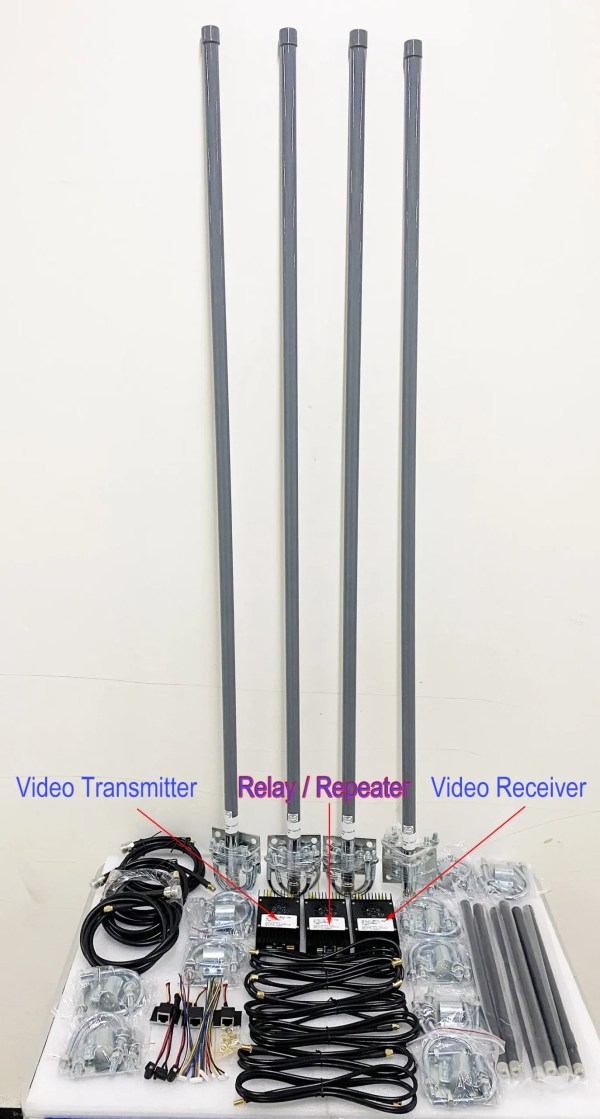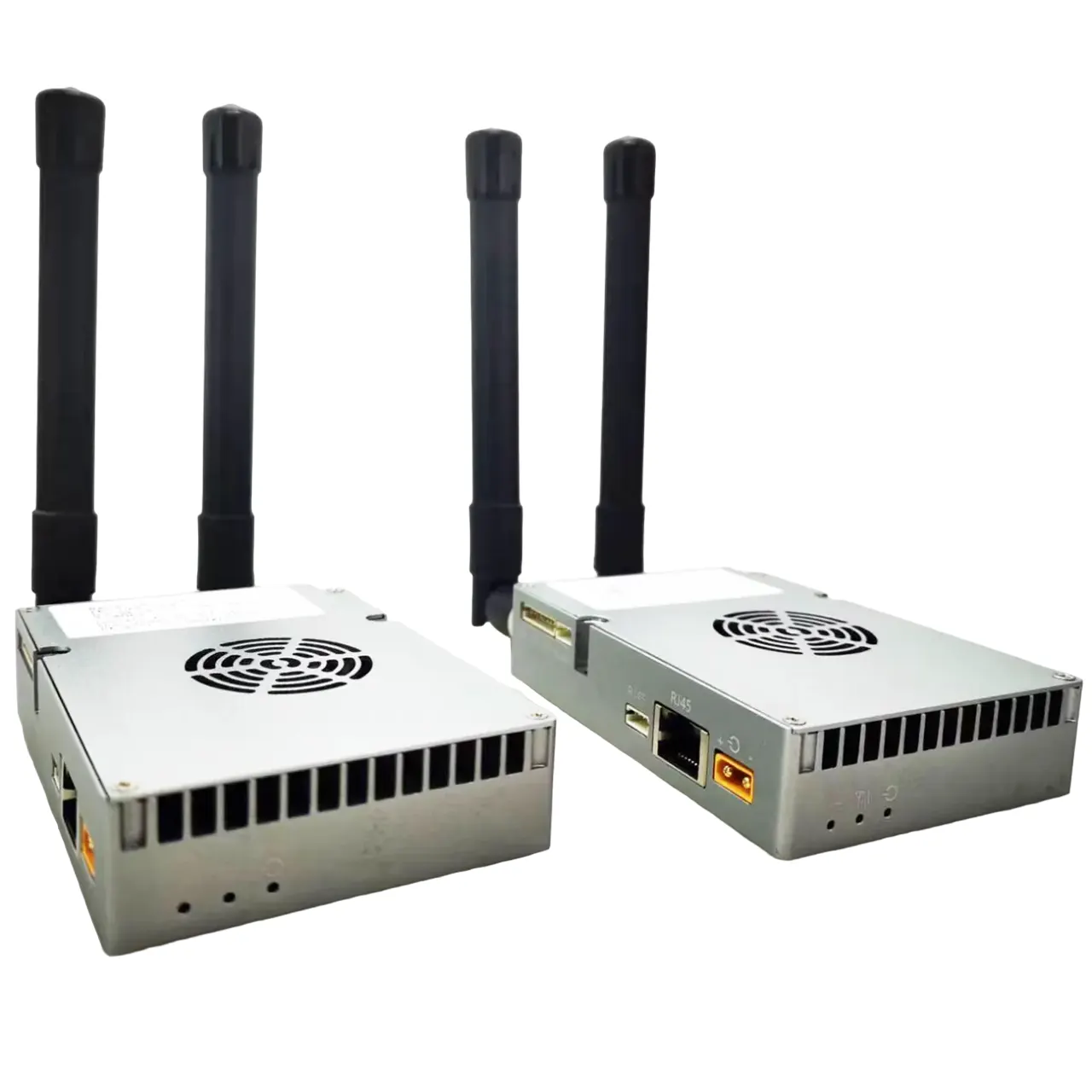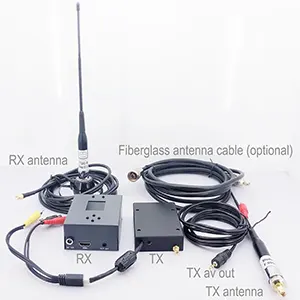Long range Video Transmitter for drones, the Ultimate FAQ Guide
Long range Video Transmitter for drones
Long-range Video Transmitter for drones, means 5-150km long-range wireless video transmitter and receiver for drones and UAVs. It is hard to choose and buy a suitable model.
You also have a lot of choices and the cost of buy-wrong is very high. Maybe you also have a lot of questions and doubts. Here I listed some questions and answer for your reference. Please feel free to contact us or Whatsapp us for any further assistance, I will try to reply to your question soon and exactly.
Table of Contents
1. Must your price be 2X for TX and RX, correct?
Yes, for the two-way bidirectional wireless video data rc link, the quotation is on the base of one unit. If you need one transmitter and one receiver, then the unit price should be 2X.
There are also customers who buy three or more sets, the middle one is the relay to extend the distance further.
There are also customers with multiple transmitters and a receiver or one transmitter and multiple receivers, the quantity is according to your needs, so the cost is unit price X quantity.
2. What is the altitude estimate to achieve 50 km and 80 km?
The flying altitude of this drone depends on your actual application. The transmission distance we mentioned here is based on the visible range. LOS (line-of-sight).
We have some clients who use weather balloons in the atmosphere (24-37km)to monitor the operation and performance of the device.
There are also more customers who use UAVs, just keeping the UAV higher than the obstacle on the grounds.
In our test video on the ground, in order to test the transmission distance from 30 to 150 kilometers, it is often necessary to climb to a high mountain of about 1,000 meters, so that the field of vision is wide.
3. What power amplifier should I choose? 2 watts or 5 watts?
The power amplifier is a signal enlarger for the longer transmission distance. We can offer you 0.3W, 1W, 2W, 5W and 10W.
Considering the 30km-50km transmission distance, it is better to choose 2 watts for 30~40km and 5 watts for 50~80km. 10 watts PA support 100~150km.
4. So each unit has a 2-way communication function correct? That means each unit can function as a repeater or relay function correct?
Yes, every unit of the two-way bidirectional model is the transceiver. You can put any unit to as the relay or repeater between the transmitter and receiver.

5. Each unit can transmit Both Video and telemetry data correct?
Yes, each unit of TX900 has two RJ45 ethernets for the IP camera. (also support extending more cameras by net switch), three data ports, and one bidirectional audio input-output.
6. Why does a 5-watt unit have several distance range? I mean there are 5 watts with 30 km, 55 km, and 80 km. Is it because of the software settings or what?
TX900 and Vcan1681 have software authorization on the transmission distance. Vcan1818 has no this setting, the transmission distance depends on the power amplifier.
7. What is the weight of 5 watts and 10 watts ??
TX900: 5 Watts: 142grams and 10 Watts 242 grams
8. What is the delay (latency) of 5 watts at 55 km and 80km?
200-300ms video (including a camera to monitor)
30-60ms data
9. About the data for telemetry, is it compatible with MavLink protocol, as I will use Pixhawk Ardupilot?
Yes, support
10. How about video quality between using 800 Mhz and 1.4 GHz? Which one is better 55 km and 80 km?
The video quality is the same at 55km and 80km.
The working frequency should choose according to your local frequency authorization policy.
If your local has DVB-T / DVB-T2 digital tv, the frequency range is from 170~860Mhz, then 1.4Ghz is recommended.
Try to avoid the frequencies already in use in the local area as much as possible to reduce interference and avoid image quality freeze or mosaic.
11. Can the frequency be set by the software correctly?
Yes, you can set the frequency at the software Web UI or via the parameter configuration board tool.
The antenna and PA power amplifier are working in the some frequency range. Their frequency range is fixed when customized.
So you should also change the antenna and PA when you modify the frequency is out of their frequency range.
For example, when you tell us you agree the working frequency is 1.4G, then the antenna and PA will be working well at the 1.4G, even if you can change the transmitter and receiver working frequency to 800Mhz, you also need to change 800Mhz antenna and PA.
12. Do you have 1.2 Ghz? This is better, considering Gps frequency.
TX900 has three frequency ranges that can be optional, 800Mhz, 1.4Ghz, and 2.4Ghz.
Vcan1818 working frequency range can be preset according to your project need.
13. If I buy the 5-watt 30km, can I upgrade in the future to a 55km or 80 km license?
when you buy it, the power amplifier and max transmission range are fixed, and can not expend by software upgrade, except that you change the hardware of the transceiver module and PA. The assembly is complex, you’d better buy a totally new one.
14. It would be nice to double-check if we can change the following parameters without rebooting the UAV radio: Frequency; Bandwidth, and Power amplifier.
Please note that our wireless transmitter module supports a frequency band. Such as 1427.9~1447.9MHz (1.4G) or 806~826MHz (800Mhz), or optional 2401.5~2481.5MHz (2.4G).
You must choose 1.4G, 800Mhz, or 2.4G when buying it. (the antenna and PA will be customized according to the frequency band).
At the frequency band, there are many frequency points. For Example, the 1.4G range is from 1427.90~1447.0Mhz. Like wifi, the module will automatically select the frequency point with the best current signal as the transmission frequency point, so you don’t need to manually modify the frequency point unless you want to change to a frequency point with the worse signal.
So our engineer doesn’t suggest that you change the frequency manually. If you still need to do it, it should change the transmitter frequency first, then change the receiver frequency to the same as the transmitter.
It is better that you reboot the transmitter and receiver. If you don’t reboot, it also can be working.
15. Our engineers would like to understand how to control the settings of the modem. Do you have an API description? What they are trying to understand is how this datalink can be integrated with our system so that datalink settings are controlled from our ground control station. Thank you.
Please check the PC AT commands at the below link.
https://ivcan.com/uart-at-command-for-wireless-video-transmitter-and-receiver/
16. Does your transceiver data transmission rate depend on transmission frequency? If yes, then what is the data transmission rate in the lowest frequency? And what is the data transmission rate in the highest frequency?
1. In the same frequency band (such as 1.4G), the transmission rate we generally refer to (also called the air interface rate) mainly depends on the wireless bandwidth (such as 10MHz, 20MHz) and wireless modulation parameters (such as QPSK, QAM16, QAM64).
2. Among them, the wireless bandwidth is set by the user (such as the wireless page under the web page), but the wireless adjustment parameters are automatically and dynamically set by the system. For example, QAM64 is used for short distances, and QAM16/QPSK is used for long distances. This is different from one-way cofdm image transmission.
3. For example, with the same configuration of 20MHz bandwidth, the air interface rate is as high as 30Mbps at short distances, but only 3~4Mbps at extreme distances.
As for what wireless adjustment parameters to use under what conditions, or the currently used wireless adjustment parameters, customers need to explore and operate by themselves.
4. What frequency band the customer chooses should not be based on the transmission rate of the high-frequency band, but also based on the legitimacy of the frequency band and whether the frequency band is “clean”. Theoretically, the radio wave in the high-frequency band corresponds to a short cycle, so the transmission time is short and the transmission rate is fast, but the specific theoretical value, I can’t answer you, the actual value, the customer can test it through the speed measurement software (the “measure” page of the TX900 webpage is integrated with IPERF speed measurement)
17. In the communication transmission kit, I need a joystick with which your equipment works.
Support.
Our system is a transparent transmission system. That means that video or data you input, we will transfer them. How to control the robot, it is your parts.
We have clients who use a PTZ camera, the receiver also has a joystick to control the PTZ camera, zoom, move or rotate.
18. The maximum distance that can be achieved in LOS (Line of sight) and NLOS (Non-line of sight) transmission?
1. In the visible range, how far our wireless transmission system can support depends on the transmission distance we mentioned and the matching power amplifier you choose when purchasing. Can be selected from 7km 15km, 30km, 50km 80km, 100km, and 150km.
2. If the transmission module you choose can support up to 100 kilometers, but you do not choose our default 5-watt power amplifier, then this distance cannot be reached.
3. It is difficult to answer how many kilometers our transmission system can transmit in the case of non-line-of-sight.
Because non-line-of-sight transmission distance depends on what is the obstacle between the transmitter and receiver?
If it is a metal-enclosed box indoors or on a mountain, the transmission distance cannot be determined.
Wireless video transmission signals are just like radio or GPS signals, they must be able to obtain signals in the presence of diffraction. Preferably in an open area.
19. Can these transceivers be used for Land-based applications such as remote surveillance of an area?
This is perfectly fine,
We also have customers who use it for long-term video surveillance in harsh situations such as borders, grasslands, mines, and reservoirs.
20. How many cameras can be connected to a single transmitter for smooth transfer of video to the receiving station?
1. Connecting more cameras also ensures smooth video, depending on the pixels you choose for video and the transmission distance.
2. Our default transmission bandwidth is 20Mbps. If you connect four or five cameras, the pixels of each camera reach 1080p, and the transmission distance is more than 30 kilometers, the video will occasionally freeze. When this happens, you can adjust the video format to a lower video pixel, or reduce the number of cameras connected to the transmitter.
21. Maximum number of transmitters that can be connected to a single receiver?
1. The answer to this question is basically the same as the previous one because the bandwidth rate of our single set of links is 20Mbps. Connecting more transmitters, each transmitter will occupy the corresponding bandwidth.
2. The smoothness of the video depends on the pixels and transmission distance of each camera you choose. Below is a video of us testing three transmitters and one receiver in our office. The picture is quite smooth.
https://youtu.be/XI0fdp_LctU
22. If multiple receivers are placed in a particular location (single site).Then how the transmitter will distinguish that from which receiver it needs to be connected?
1. Every transmitter and every receiver has its unique IP address. Which transmitter and camera you access from the receiver depends on whether you know the IP address you set beforehand. This ensures that, even if many sets of transmitters or receivers are in the same location, you can only access devices whose IP addresses you know.
2. At the same time our transmission and reception also support AES encryption and decryption. Even if other unauthorized users know your IP address, they cannot access or view the video of the transmitter and camera to ensure the privacy of wireless transmission.
23. NVR integration procedure if live transmission and video recording are done simultaneously.
1. Most of our customers use the RTS player of the computer to watch or record the video content of the IP camera.
2. If you need to set up NVR, our engineers can provide setup assistance according to your NVR-specific equipment.
24. Provision of circuit diagram and the architectural details of transceiver?
1. My engineers and I will provide detailed help and remote configuration according to your project needs.
2. For specific technical information, according to your needs, we will judge whether it can be opened for free. But we will definitely ensure that you can use the device normally.
25. Is it possible for 100 kms or more long distance above see?
If used 10W power amplifier, it can reach 150~200km. (NLOS)
Because of the curvature of the earth, which creates obstructions between the transmitter and receiver, and requires longer distances, it is necessary to ensure that the aircraft flies high enough or use an intermediate mission aircraft as a relay.
26. We conduct a long-range automatic flight today. The drone lost connection the first time at 11Km and it did not auto-reconnect for the whole flight. When the drone landed automatically, we restarted both modules manually then they connected again. Data Port D1 is not used. D2 is SBUS, D3 is TCP server
According to our understanding, the hottest part should be the air unit(the access node), because the environment inside the aircraft is very narrow and closed.
1. The next time you find this kind of problem, you need to use the elimination method, because in general, the probability of unilateral problems is higher. For example, if we suspect that there is a problem with the access node at the aircraft unit. then we only restart the access node at the aircraft unit. Do NOT restart the central node on the ground side to see if you can connect after restarting the access node on the aircraft side, there is a high probability that there is a problem with the access node on the aircraft side.
2. If there are conditions, for example, if the wired network port of the access node on the aircraft is exposed, then you can connect it to the computer, and log in to the wireless link web page (default 192.168. 1.12). On the debug page, send any AT command, and check whether the wireless transmission system can respond to AT commands normally.
3. There is a link core module in our transmitter and receiver. It has a log function. Before the flight, it will always record the operation status of the wireless link. When there is a problem, return to the ground, export the log information, and send the log file to MorningCore Help to analyze the reason there. How to get Log files to analyze and resolve TX900 link interruption faults.
27. If we use the transceivers how about security it is safe because we do not want to hack our data from hackers else
Our wireless video data transmission system supports AES 128 encryption, Banks also use this encryption algorithm. for more information, you can google search aes128.
28. Can you show me the pictures of the UAV radio link antenna U-shaped mountain clamp and coaxial cables?
1. U-shaped mountain clamp for 120cm Receiver fiberglass FRP antenna
2. 150cm Coaxial cables for 29cm transmitter antenna 
3. 150cm Coaxial cables for 120cm receiver antenna


29. Have you tested that your 5w OFDM VTX can reach about 55 km directly without a repeater? If yes, what is the Altitude of the drone?? Is it really LOS without any obstacles?
It can go directly to 55km, and the height of the aircraft should be more than 300 meters. It is best to see through, without occlusion, or there is basically no occlusion near the antenna.
30. What is the power consumption of the 5 w VTX in Voltage and current?
The average power consumption of the video transmitter is less than 1.1A@24V, and the average power consumption of the video receiver is less than 0.8A@24V. Power supply range 24~28V.
31. Can it use lipo batteries? 6S battery?
Support lipo batteries.
6S battery: 3.76=22.2V, 4.26=25.2V, that is, 22.2~25.2V, no problem.
32. Please tell us the HS code for your long-range two-way drone video transmitter and receiver system?
Some clients used the HS code 8517799000.
33. Does it support the Mavlink protocol? I can just attach the air unit with my flight controller, or do I need to set the Mavlink protocol communication in the transceiver? So it doesn’t need any configuration for Mavlink?
Yes, our long-range drone wireless transmitter and receiver supports Mavlink protocol and flight control. Please check the operation at the below link.
https://www.youtube.com/watch?v=KJ7JMZZNgcI
https://www.youtube.com/watch?v=9uI_KZlKeOQ
34. When shipped, your TX900 sample is equipped with three data ports that are TTL.
We can customize them for you according to your demand.
35. Are they in pairs if I buy the device? I mean, for the receiver and transmitter. I’m planning to transmit a video stream wireless with an 18km distance.
Yes, for the transceiver, it is better to buy at least 2 pcs for one pair.
You need to buy two, one for transmission and one for reception.
36. Hello, I am interested in a communication line for UAVs for video and telemetry transmission.
36.1. What was the maximum range you received with a transmitter power of 10 watts and at what altitude?
ivcan: TX900-10W-150km, Our clients can work well at 150~200km at the 1000-meter altitude. We tested 110km from the mountain top to the seaside. https://youtu.be/r1X4AU1togE
36.2. Communication via Ethernet supports all standard protocols and are there any restrictions on UDP protocols? Or the modem is absolutely transparent from a network point of view?
ivcan: Yes, our wireless link is like an invisible net cable, it supports almost ethernet protocols, TCP/ IP, etc. TX900 also supports absolutely transparent transmission.
36.3 Encryption is only possible with NPP 128, or is it possible with 256?
ivcan: TX900 support AES128 encryption.
36.4 Is the mesh function available for this modem?
ivcan: TX900B has the IP mesh function. There are three versions of the transmission distance: 3km, 10km, and 50km.
36.5 Is it possible to quickly change the operating mode (during the flight) of the repeater between point to point?
ivcan: Sorry, it can not change the operating model during the flight. You can change the role of the transceiver to the transmitter, receiver, or repeater on the ground.
37. How to add the IP camera video stream on my mission planner software?
I have an IP camera attached to the transmitter airborne. The video feed is being received on the receiver side. I can see the video feed in the IPCAM application. But now I want the video feed inside my mission planner software.
Answer: Right-click on the HUD. There are several options to choose from. 
Please get help at the below link.
https://ardupilot.org/planner/docs/mission-planner-flight-data.html
38. My requirement was only 1 km but with a high bandwidth (for data and video), at least 30Mbps – 50Mbps (24VDC power). also kindly send a datasheet of the unit.
Ok, One of our TX900 sub-models can support 30 to 50Mbps.
39. Is TX900 possible to connect a camera with RTSP protocol to the transmitter?
Yes, TX900 supports a camera with RTSP protocol.
It also supports an IP ethernet protocol camera, which you can submit camera PTZ (Pan/Tilt/Zoom).
40. What is included in the package of your TX900 whole set?
The TX900 default set includes one transmitter and one receiver, two 29cm transmitters, and two 120cm receiver antennae.
41. Why do you recommend using D2 / D3 as the data port?
D1 is the transparent serial port of the core wireless link modem. It is designed to ensure real-time performance but not the serial port data frame structure.
42. Why should I re-power the air unit when the air unit and ground reconnection?
We have a situation when the air and ground units are disconnected, they won’t be connected automatically. If I power the air unit off and on, they reconnect.
Please show us more details and our engineer will offer you the specific solution.
43. Does your model TX900 support 4k 60fps?
Now it supports 4k 30fps, 3840*2160@30fps




